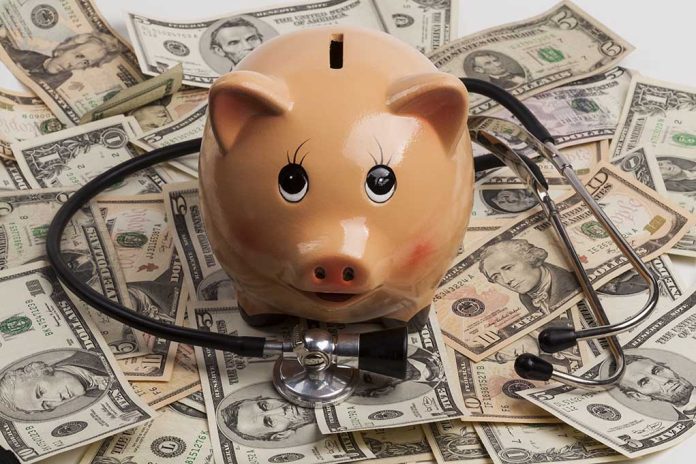
A nonprofit organization is wiping out $30 billion in medical debt for 20 million Americans, but questions remain about whether this approach addresses the root causes of the healthcare affordability crisis.
Key Takeaways
- Undue Medical Debt is eliminating $30 billion in unpaid medical bills for 20 million Americans, with residents of Texas and Florida representing about half of the relieved debts.
- The transaction, costing $36 million to complete, was made possible when debt collector Pendrick Capital Partners decided to close its operations.
- Despite this massive debt relief effort, it addresses only a fraction of the estimated medical debt affecting approximately 100 million Americans.
- Critics argue that while debt forgiveness provides immediate relief, it fails to address the systemic problems in healthcare financing that create medical debt in the first place.
- The approach combines philanthropic giving with taxpayer dollars and raises questions about sustainable solutions to the medical debt crisis.
Record-Breaking Debt Forgiveness Deal
Undue Medical Debt has struck a groundbreaking deal with Pendrick Capital Partners to forgive $30 billion in medical debts owed by approximately 20 million Americans. The transaction, which cost $36 million to close, represents the largest single medical debt relief effort in American history. The deal primarily benefits residents of Texas and Florida, who account for roughly half of all the forgiven debts. Recipients must meet specific criteria to qualify for relief, including having incomes at or below four times the federal poverty level or medical debts exceeding 5% of their annual income. The average forgiven debt amounts to approximately $1,100 per person.
This massive debt forgiveness became possible when Pendrick Capital Partners, a debt collection company, decided to exit the market. About half of the debts being retired are over seven years old and were donated by Pendrick, while the remainder were purchased at pennies on the dollar. Undue Medical Debt plans to spend an additional $40 million to process these debts and inform affected patients that their obligations have been eliminated, effectively removing these financial burdens from their credit reports and stopping collection activities.
A Drop in the Ocean of Medical Debt
While the $30 billion debt forgiveness represents a significant achievement, it addresses only a fraction of the medical debt problem in America. An estimated 100 million Americans struggle with medical debt, and they borrowed approximately $74 billion in the past year alone to pay for healthcare services. The situation highlights fundamental challenges in how healthcare is financed in the United States, where even insured patients often face substantial out-of-pocket costs that can quickly become unmanageable for middle and working-class families.
Allison Sesso, Undue Medical Debt chief executive, said, “We don’t think that the way we finance health care is sustainable. Medical debt has unreasonable expectations…the people who owe the debts can’t pay.”
The transaction also reveals troubling realities about debt collection practices. Debt buyers like Pendrick purchase unpaid medical bills from hospitals and healthcare providers at steep discounts, typically paying just pennies on the dollar. They then attempt to collect the full amount from patients, often employing aggressive tactics that can include lawsuits, wage garnishments, and property liens. This system disproportionately affects lower-income Americans who lack the resources to fight back against collection efforts or negotiate settlements.
Treating Symptoms Rather Than the Disease
Critics of debt forgiveness programs argue that while they provide immediate relief to affected individuals, they fail to address the fundamental flaws in the healthcare system that generate medical debt in the first place. Without structural reforms to how healthcare services are priced and paid for, new debts will continue to accumulate at alarming rates. Some healthcare policy experts advocate for more comprehensive solutions that would prevent medical debt from being incurred, such as expanded insurance coverage, caps on out-of-pocket expenses, and price transparency measures.
Elisabeth Benjamin, a vice president at the nonprofit Community Service Society of New York, said, “The approach is just treating the symptoms and not the disease.”
Undue Medical Debt operates through a unique model, using charitable donations to purchase and forgive medical debts. The organization has expanded its approach to work directly with hospitals and healthcare providers before debts are sold to collection agencies. It has also partnered with state and local governments to address medical debt in specific communities. While these efforts provide tangible relief to affected individuals, even the organization’s leadership acknowledges that broader national solutions are needed to truly address the medical debt crisis affecting millions of Americans.
The Path Forward
The debate over medical debt forgiveness highlights deeper questions about healthcare financing in America. While proponents argue that debt relief provides immediate financial and psychological benefits to struggling families, others contend that resources might be better directed toward preventing medical debt through systemic reforms. State leaders across the country have begun implementing measures to protect consumers from the worst effects of medical debt, including regulations that prevent medical debts from affecting credit scores. However, comprehensive national action remains elusive.
Recent developments have complicated efforts to protect consumers from medical debt. The Trump administration suspended regulations that would have barred credit reporting of medical debt, and congressional Republicans are moving to permanently revoke these rules. Meanwhile, organizations like Undue Medical Debt continue their work, recognizing that while debt forgiveness provides immediate relief to millions, the long-term solution requires fundamental changes to how Americans pay for healthcare services.
Sources:
- https://www.mainepublic.org/2025-04-04/major-deal-wipes-out-30-billion-in-medical-debt-even-backers-say-its-not-enough
- https://www.wusf.org/2025-04-04/major-deal-wipes-out-30-billion-in-medical-debt-even-backers-say-its-not-enough
- https://www.npr.org/sections/shots-health-news/2025/04/04/nx-s1-5349500/major-deal-wipes-out-30-billion-in-medical-debt-even-backers-say-its-not-enough










